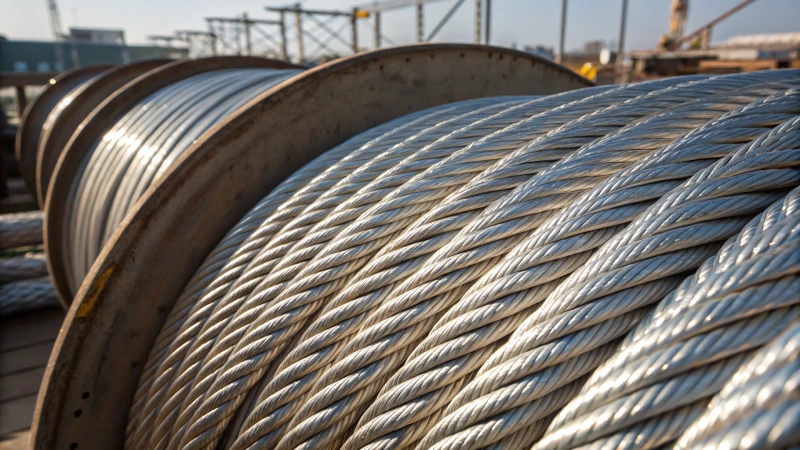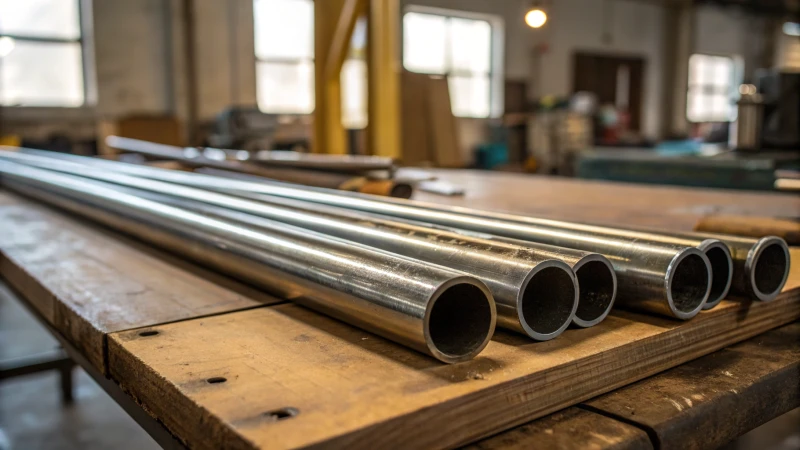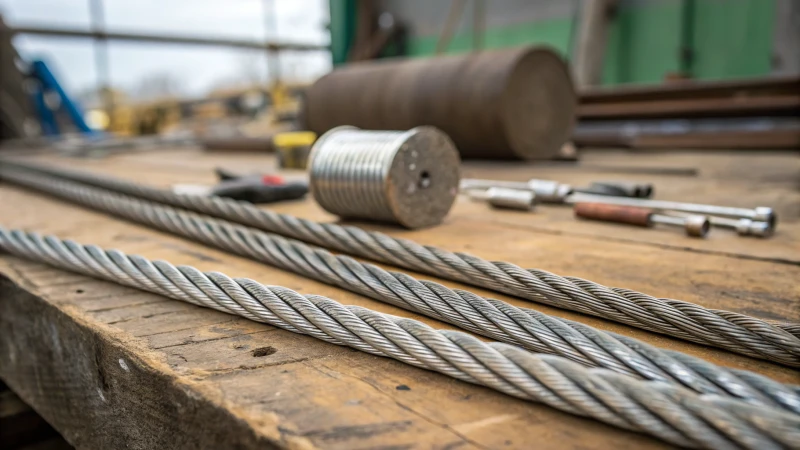
Imagine you're deep underwater, surrounded by endless blue, and your cable system is your lifeline.
Corrosion-resistant steel wire ropes are perfect for subsea cable installations because they endure the harsh marine environment. These ropes provide superior durability, minimize maintenance, and enhance performance by resisting seawater and pressure damage, ensuring your operations remain reliable and efficient for the long haul.
Picture this: I'm overseeing a subsea project, and I need materials that won't buckle under pressure—literally. That's why I swear by corrosion-resistant steel wire ropes. They save me from the headaches of constant repairs and ensure that everything runs smoothly, even when the ocean decides to throw a tantrum. In the following sections, I'll share more about how these robust ropes have transformed my projects, providing peace of mind and reliability when it's needed most.
Corrosion-resistant ropes reduce maintenance needs in subsea installations.True
Their resistance to seawater damage minimizes the frequency of repairs.
Non-corrosion-resistant ropes are ideal for subsea cable installations.False
They fail quickly due to seawater exposure, needing frequent replacements.
Why Are Some Steel Wire Ropes More Corrosion Resistant Than Others?
Ever found yourself wondering why some steel wire ropes seem to laugh in the face of rust while others just crumble? It’s all about those magical corrosion-resistant properties.
Steel wire ropes achieve corrosion resistance through strategic material choices like stainless steel, protective coatings such as galvanization, and specialized treatments. These elements work together to shield the ropes from environmental wear and tear.

Material Composition
Let's start with the basics—material composition. I remember the first time I learned about the magic of stainless steel. Imagine a superhero in the metal world, battling rust with its trusty sidekick, chromium. This duo forms an invisible protective shield on the steel's surface, making stainless steel a top choice for wire ropes that need to resist corrosion.
Consider a comparison table1 showcasing different steel types:
| Steel Type | Corrosion Resistance | Key Element |
|---|---|---|
| Stainless Steel | High | Chromium |
| Galvanized Steel | Moderate | Zinc Coating |
| Carbon Steel | Low | Carbon |
Protective Coatings
Then there's the fascinating world of protective coatings. Picture this: you're walking in a rainstorm with nothing but a flimsy umbrella. Not great, right? Now, imagine swapping that for a top-notch raincoat—that's what galvanization does for steel wire ropes. By wrapping them in a zinc coating, it sacrifices itself to the rust, leaving the steel safe and sound beneath.
For those curious minds, explore more on galvanization processes2 and how they act as a rust-fighting shield.
Specialized Treatments
But wait, there's more! Sometimes, standard coatings just won't cut it. Enter specialized treatments like polymer coatings or anodizing. These are like those heavy-duty parkas you pull out for a blizzard. They offer additional layers of protection, perfect for industrial needs or when facing relentless environments.
In marine settings, for instance, polymer coatings3 are a go-to for their saltwater resistance.
Environmental Considerations
Of course, picking the right steel wire rope isn't just about the rope itself—it's about where it's going to be used. I’ve learned that understanding the environment is key. Factors like humidity, temperature, and exposure to chemicals can dictate how much protection is necessary. For example, in subsea applications where salinity is a real beast, opting for stainless steel or heavily coated ropes is a no-brainer.
Dive into different environmental impacts4 on steel wire ropes and see how they influence your choices.
By keeping these factors in mind, I’ve been able to make smarter decisions that not only extend the life of my steel wire ropes but also keep operations running smoothly across various industries.
Stainless steel wire ropes resist corrosion due to chromium.True
Chromium forms a protective layer, enhancing stainless steel's resistance.
Galvanization involves coating steel with aluminum for protection.False
Galvanization uses zinc, not aluminum, to protect steel from corrosion.
How Does Corrosion Resistance Improve Installation Efficiency?
Ever wondered how a simple change in material could revolutionize your project's efficiency? Let me share how corrosion resistance is a game-changer.
Corrosion resistance boosts installation efficiency by cutting down maintenance needs, ensuring steady performance, and prolonging material lifespan. This translates to lower costs and less downtime, which is vital for industries in tough environments.

The Role of Corrosion Resistance in Installation Efficiency
Corrosion resistance is a vital factor in selecting materials for industrial and construction applications. By mitigating the effects of corrosion, materials such as stainless steel or galvanized metals can significantly enhance installation efficiency. For example, in subsea cable installations, corrosion-resistant wire ropes can endure harsh marine environments without degrading, thereby minimizing maintenance needs.
I remember working on a project where we had to lay subsea cables. We faced the relentless challenge of marine corrosion. Switching to corrosion-resistant wire ropes was like a breath of fresh air. Suddenly, the cables lasted longer, and we weren't scrambling for replacements every few months. This transition not only reduced our maintenance headaches but also enhanced overall efficiency. In industries like mining and offshore drilling, where every minute of downtime hits hard financially, this reliability is crucial.
Economic Benefits of Corrosion Resistance
Implementing corrosion-resistant solutions translates into economic benefits. Reduced maintenance costs mean that resources can be allocated more efficiently, improving overall project budgets.
I can't stress enough the economic upsides. There was a time when we swapped out our traditional steel for corrosion-resistant alternatives, and the impact on our budget was immediate and positive. Maintenance costs plummeted, freeing up funds for other critical areas.
For instance, a study highlighted that using corrosion-resistant materials5 in construction projects could improve efficiency by up to 20% due to lower maintenance requirements.
| Benefit | Description |
|---|---|
| Reduced Maintenance | Less frequent repairs and replacements needed. |
| Consistent Performance | Reliable operation even in harsh conditions. |
| Cost Savings | Lower long-term operational costs. |
Materials Enhancing Corrosion Resistance
Selecting the right materials can profoundly impact the efficiency and longevity of installations. Stainless steel and specially coated metals are popular choices for their durability and ability to resist environmental stressors.
Choosing the right materials can dramatically affect the lifespan and efficiency of installations. I’ve often opted for stainless steel or specially coated metals for their resilience.
For instance, stainless steel grades like AISI/SUS 304 and 316 are preferred for their superior resistance to corrosion in marine applications.
The choice of material often depends on the specific environmental challenges faced by an industry:
- In one project exposed to harsh weather, we chose galvanized steel, which made all the difference against rust.
- Similarly, in mining settings where high-strength alloys have been lifesavers enduring wear and tear that would otherwise cause rapid degradation.
Learn more about stainless steel grades6 and their applications to understand how they can enhance project outcomes by ensuring long-lasting, efficient installations.
Corrosion-resistant materials reduce installation downtime.True
They require less maintenance, ensuring operations run smoothly.
Galvanized steel is unsuitable for marine applications.False
Galvanized steel offers protection against rust in marine environments.
How Do Corrosion-Resistant Ropes Save Money in the Long Run?
Picture this: a world where ropes defy the harshest elements, cutting down costs and maximizing safety. Intrigued? Let me tell you more.
Corrosion-resistant ropes offer significant long-term savings by reducing maintenance needs and extending durability. This translates into fewer replacements and enhanced performance in challenging environments, ultimately leading to substantial cost reductions over traditional materials.

Delving into Material Longevity and Cost Efficiency
You know those moments when you're knee-deep in a project, and the last thing you need is equipment failure? I’ve been there, trust me. Whether you're like me, working in subsea cable installations7 or any other demanding field, corrosion-resistant ropes can be a game-changer. They're crafted from robust materials like stainless steel, designed to brave the toughest conditions. Imagine fewer replacements, less downtime—this means more seamless operations without the dreaded pause for repairs.
| Traditional Ropes | Corrosion-Resistant Ropes |
|---|---|
| High maintenance | Low maintenance |
| Frequent replacement | Extended lifespan |
| Susceptible to damage | Resistant to harsh elements |
Boosting Safety and Efficiency
Let’s talk safety—something I always have at the forefront of my mind. In mining, for instance, a colleague named Emma8 swears by these ropes. They maintain their integrity under extreme conditions, minimizing risks of failure that could lead to accidents. Their reliability means you’re not constantly watching over operations, which lets your team focus on productivity instead.
Additionally, enhanced operational efficiency is achieved as these ropes perform consistently over time, eliminating the need for constant supervision and adjustments.
Weighing Long-Term Investment vs. Short-Term Costs
Sure, the initial cost of corrosion-resistant ropes might make you wince, but think about it: fewer replacements and reduced maintenance costs add up to long-term savings. An analysis of industry data9 reveals a potential 20% boost in installation efficiency with these ropes.
- Initial Cost: Higher upfront investment
- Maintenance Cost: Reduced ongoing expenses
- Replacement Cost: Fewer replacements needed over time
It’s about seeing beyond the immediate expense and understanding the strategic value of investing in quality materials that stand the test of time.
Corrosion-resistant ropes require less maintenance than traditional ropes.True
Corrosion-resistant materials withstand harsh conditions, reducing maintenance needs.
Initial cost of corrosion-resistant ropes is lower than traditional ones.False
Corrosion-resistant ropes have a higher upfront cost due to material quality.
How Do You Choose the Perfect Wire Rope for Your Subsea Project?
I remember the first time I had to choose a wire rope for an underwater project, and it felt like diving into an ocean of choices.
To select the right wire rope for your subsea project, focus on corrosion resistance, tensile strength, fatigue life, and the specific environmental conditions. Look for ropes with advanced coatings and materials like stainless steel to endure the extreme underwater environments.

Key Factors in Selecting Subsea Wire Ropes
When I first started working on subsea projects10, the importance of choosing the right wire rope quickly became clear. The wrong choice could lead to costly setbacks and safety hazards. Here are some insights I've gathered over the years:
1. Corrosion Resistance
I've learned that subsea environments are incredibly harsh, with high salinity levels that can degrade materials faster than you might think. Choosing wire ropes made from stainless steel11 or those with advanced anti-corrosion coatings can extend their lifespan significantly. I've seen AISI 316 stainless steel ropes outperform others, thanks to their superior corrosion resistance.
2. Tensile Strength
Understanding tensile strength is crucial because these ropes need to handle immense loads. I always review the tensile strength specifications12 to ensure the rope will meet the project's demands.
| Material | Typical Tensile Strength (N/mm²) |
|---|---|
| Stainless Steel | 1570-1770 |
| Galvanized Steel | 1370-1570 |
Typically, stainless steel ropes offer a tensile strength between 1570-1770 N/mm², which provides peace of mind when dealing with heavy loads.
3. Fatigue Life
Subsea applications mean constant movement and bending, which can lead to fatigue. I've found that selecting ropes designed with higher fatigue resistance—like those with more wires per strand—can distribute stress more evenly and last longer.
4. Environmental Factors
Every subsea environment is unique, and factors like temperature and water currents can affect wire rope performance. For colder waters, I recommend ropes that maintain flexibility at low temperatures, ensuring they function optimally regardless of the conditions.
Advanced Material Options
Exploring advanced materials has been a game-changer in my projects. Some ropes incorporate synthetic fibers to improve buoyancy and reduce weight without compromising strength. This innovation is especially helpful in dynamic environments where weight is a limiting factor.
By considering these factors and consulting with experts or suppliers, I've been able to select wire ropes that perform reliably throughout my projects' lifecycles. Making informed choices not only optimizes efficiency but also ensures safety and durability in challenging subsea conditions.
Stainless steel ropes are more corrosion-resistant than galvanized ones.True
Stainless steel, like AISI 316, offers superior corrosion resistance.
Galvanized steel ropes have higher tensile strength than stainless steel.False
Stainless steel ropes typically have higher tensile strength values.
Conclusion
Corrosion-resistant steel wire ropes enhance subsea cable installations by providing durability, reducing maintenance needs, and ensuring reliable performance in harsh marine environments, ultimately leading to cost savings.
-
This link provides a detailed comparison of various steel wire rope materials, helping readers choose the best option for their specific needs. ↩
-
Discover how galvanization works to protect steel from rust, offering valuable insights into its effectiveness and applications. ↩
-
Understand why polymer coatings are essential for enhancing corrosion resistance, particularly in harsh environments. ↩
-
Explore how different environmental factors impact steel wire ropes and what measures can be taken to mitigate these effects. ↩
-
Exploring this link will provide deeper insights into how corrosion-resistant materials contribute to operational efficiency across various industries. ↩
-
Understanding stainless steel grades helps choose the right material for specific environments, optimizing project performance and longevity. ↩
-
Explore how corrosion-resistant ropes enhance efficiency and durability in subsea cable installations, offering insights into industry-specific advantages. ↩
-
Learn about safety improvements in mining operations through the use of corrosion-resistant ropes, focusing on durability and reliability. ↩
-
Understand the financial benefits of choosing corrosion-resistant ropes over traditional ones by examining cost efficiency and long-term savings. ↩
-
Explore why choosing the right wire rope is critical for subsea projects, focusing on safety and efficiency. ↩
-
Learn how stainless steel enhances corrosion resistance in marine settings. ↩
-
Understand how tensile strength impacts wire rope performance in demanding conditions. ↩

